#ancient buddhist ruins
Photo
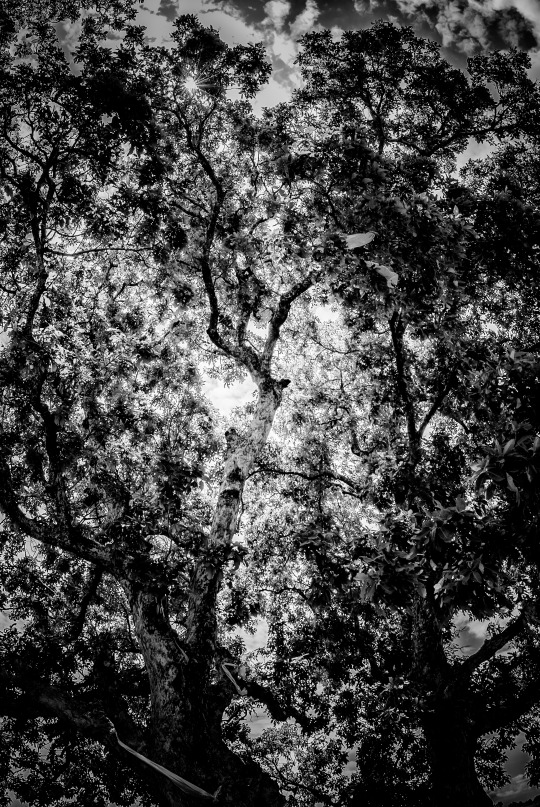
June 2011 KTM Kathmandu Nepal Road to Lumbini
© KOJI ARAKI Art Works
Daily life and every small thing is the gate to the universe :)
#2011#June 2011#ktm#kathmandu#nepal#Road to Lumbini#Lumbini#2nd day in Lumbini#the 2nd day#Tilaurakot#Kapilavastu#The ancient Sakya Kingdom#Sakya Kingdom#ancient buddhist ruins#ancient buddhist landmark#buddha tree#linden#tree#photographers on tumblr#b&w photography#black and white photography#original photography#photography#koji araki art works#PENTAX K10#SIGMA 15mm 2.8 EX Fisheye#Fisheye#SIGMA#PENTAX
78 notes
·
View notes
Text
i am, plagued by thoughts.
someone almost overtrimming Ao Lie's hooves and Wukong eats their hide for it, but nobody wants to ask him to look after the white horse lest they provoke the old BiMaWen, and Ao Lie begs him to look after him cus gods he can't go lame in the middle of their journey!
which leads me to, Ao Lie getting so so pampered by Wukong, his dragon scales and talons never shone as much as his pelt and hooves thanks to his fellow pilgrim;
during a colder snap they realize they don't have enough layers for their Shifu, until Wukong suggests Wujing's sash which, leads to Sanzang looking like a bundled pile on Long Ma's back;
Sanzang chiding Bajie and Wukong about talking too loudly at night and he can't sleep / everyone else nagging their Shifu to pleaaaase turn off the lamps and go to bed already, your eyes will go sour reading at night!!
Wukong being more restless than usual out of sheer joy of being able to move freely after 500 years, and using Wujing as a jungle gym;
the inherent comedy of the pilgrims having such stark height differences. poor Wujing desperately crawling into caves and ruined temples until Wukong and Bajie teaches him to change his size;
the ancient china tetris game of figuring out how to make all the artifacts and scrolls Sanzang collects along the way fit into the massive carrier they gave Wujing, which often leads Wukong to show off his strength by, juggling priceless artifacts like they weigh nothing, but Sanzang can't use the headache mantra lest Wukong actually drops them;
speaking of, Bajie stashing food inside the bag and then not being able to get to them cus the items are too heavy for him, and now he's suffering smelling the food go bad and not being able to eat it;
Wukong mocks him relentlessly for it once Sanzang finds the spoiled snacks almost rotted some of the relics;
Wukong ending up as the group's translator for a hot few months until everyone learns the new languages they come across, which leads to endless opportunities for speech-related pranks;
Sanzang being dismayed that Wukong's calligraphy with his feet is better than with his hands;
Also, him trying to hammer in Buddhist scripture into their heads during the Vassas, and it's like herding superpowered cats;
The inherent comedy of Wukong doing small talk with the animals of the mountains they go through in beast-speech, while everyone goes ????
90 notes
·
View notes
Text
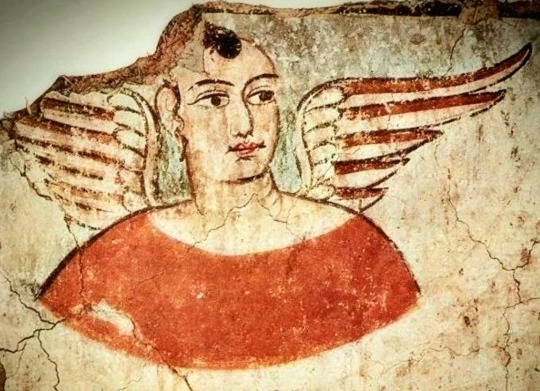

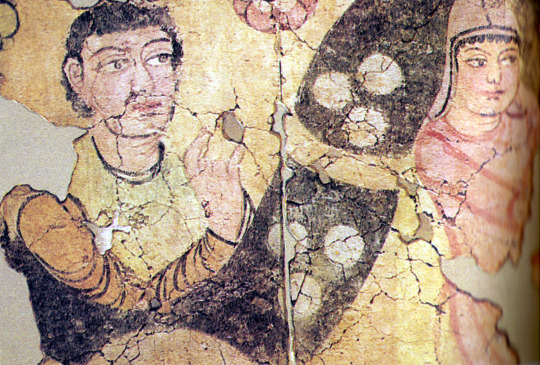
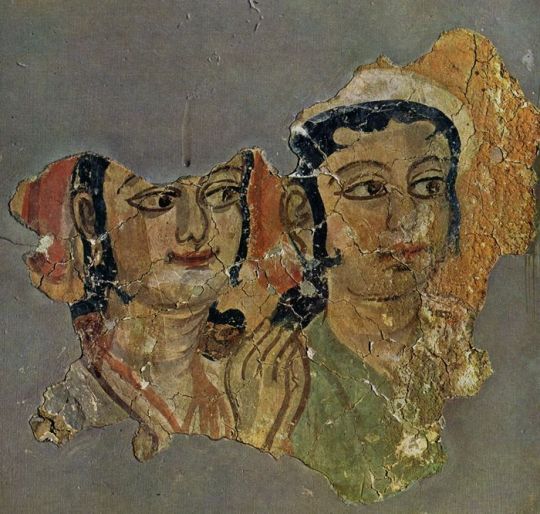

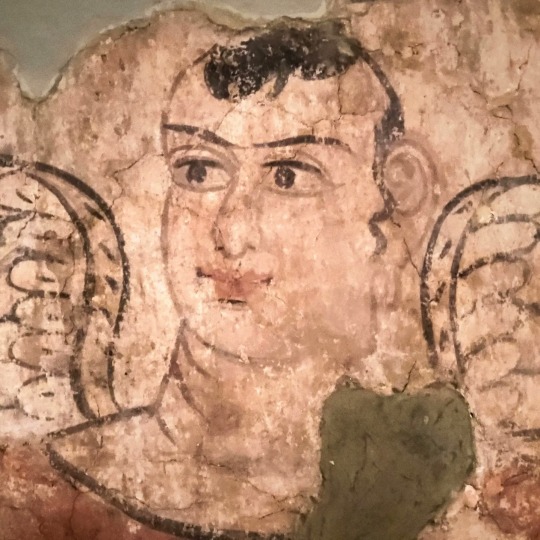
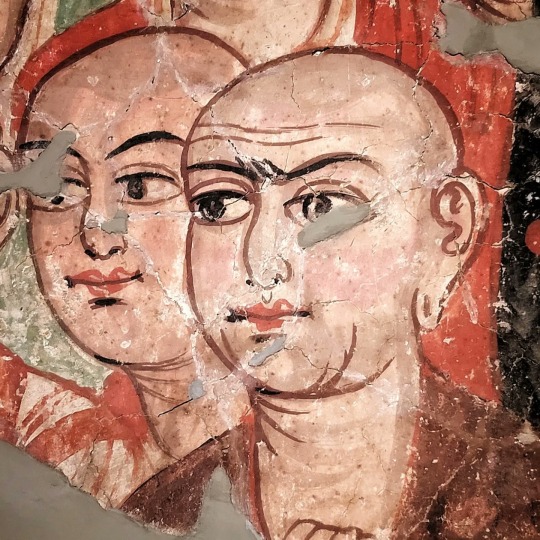
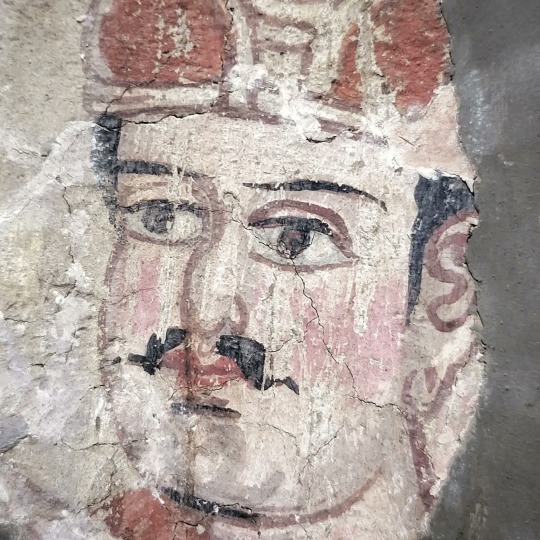

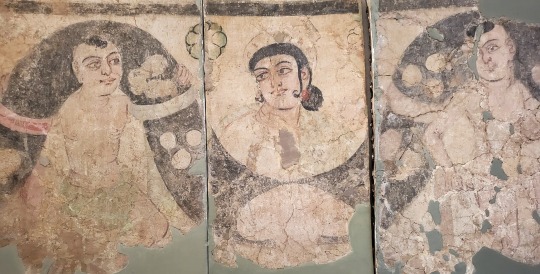




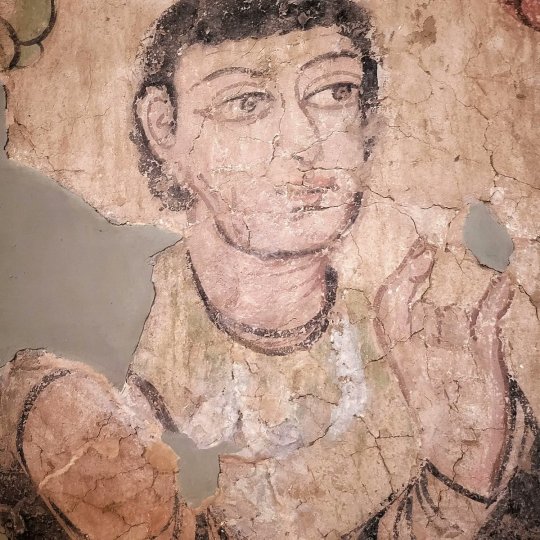

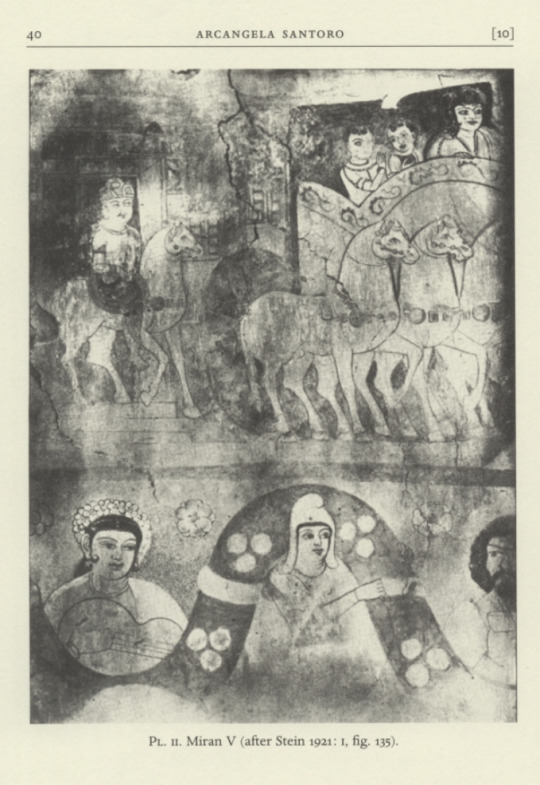
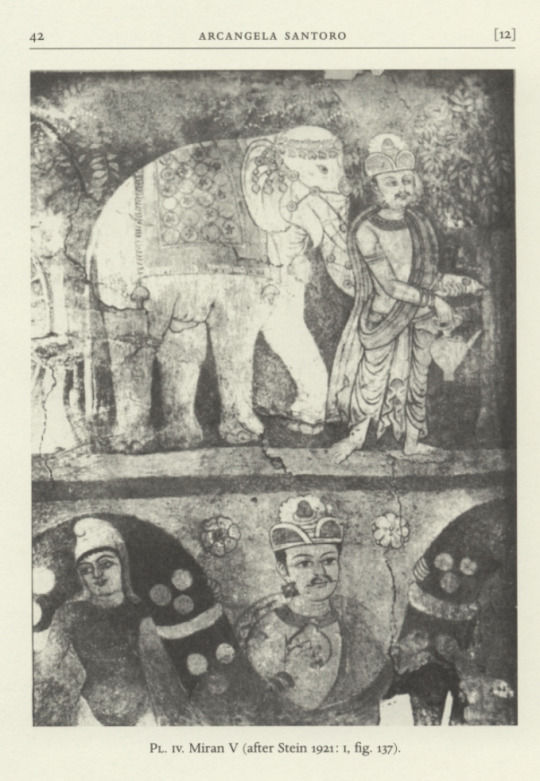



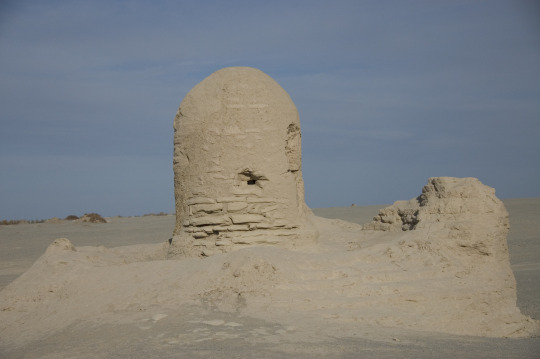
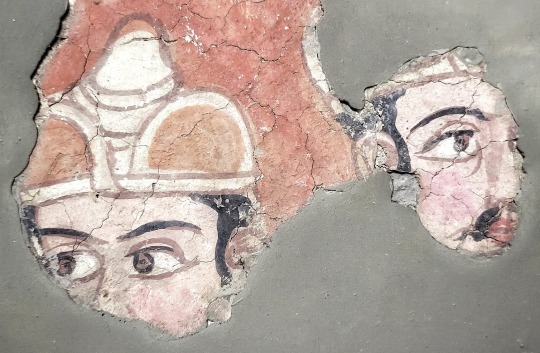
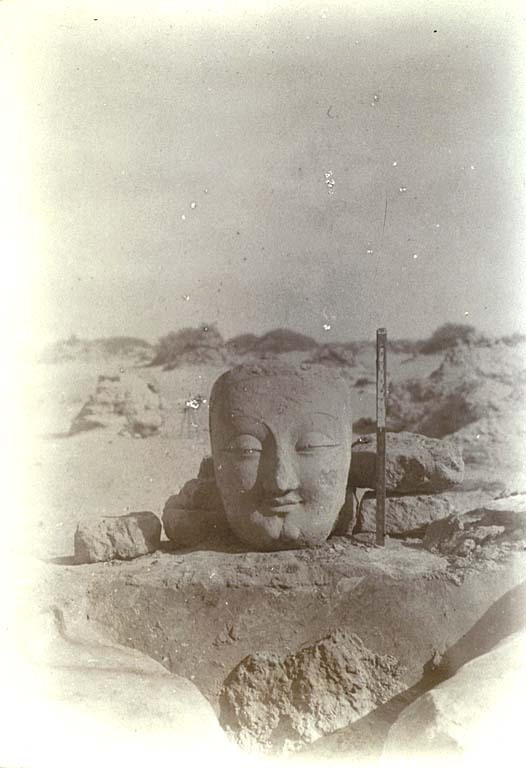
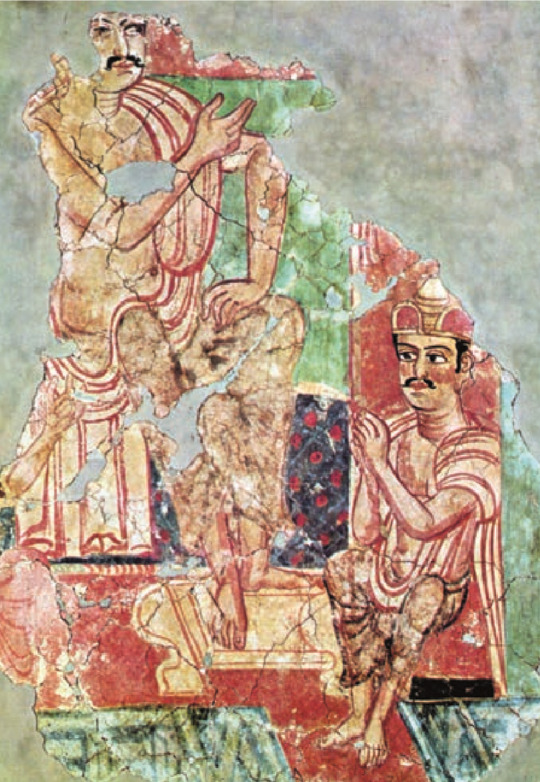
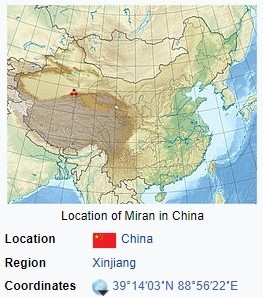


Fragments of the Buddhist monastery at Miran (Xinjiang) 3rd-5th C. CE by Titasa (Tita/Titus?) & other unknown artists. More images (and sources) on my blog, link at bottom.
I'm not 100% sure what nations the people in the photos belong to. They lived in Loulan (aka Kroraina). They used the Indo-European Gandhari language in their writing. They wrote in Kharosthi script which was also (at least partially) used by the Saka of Khotan, Kushan Empire, Sogdians, and Bactrians. Some suspect the artist (or one of the artists) may have been a traveler from the Roman Empire because of his art style and the name "Titasa".
"The Miran murals, now housed in the National Museum of New Delhi, are too delicate to travel (see frontispiece) but Stein found thousands of other items at the many desert ruins at the ancient town of Cadota, north of present-day Niya. These included Gandhari documents in Kharosthi script (cats. 27, 40, 44, 45, 46, 47) 74, 75, 76, 77, 89, 141): administrative records, letters and legal documents, some sent by the king of Kroraina to the ruler of Cadota. They offer a unique glimpse into the concerns of these oasis settlements, especially when placed in context of the archaeology. Stein explains how the sites had been abandoned over time and thus cleared of any items of intrinsic value, but ‘...the manifold other relics, however humble, which had safely rested in the sand buried dwellings and their deposits of rubbish... all help to bring vividly before our eyes details of ancient civilisation that without the preserving force of the desert would have been lost for ever.'
Miran, Cadota and the other towns of Kroraina seem to have been largely deserted by the fifth century. Defeated by the Northern Wei in 445 and with a warming climate making the route through the Lop Desert to Dunhuang no longer viable, people started moved out. The irrigation canals silted up and the dwindling population was unable to provide enough labour to continue to make the land sustainable.
Although not an ocean of emptiness, the analogy of an ocean for this area is a useful one.” The peoples and cultures moved like currents some, like the Gulf Stream, travelling great distances while retaining distinct characteristics, influencing the lands they passed by. Others were merged into more powerful currents, or soon settled on the ocean floor to nourish local cultures. The Yuezhi/ Kushan and the Xiongnu were examples of the first — powerful swirling currents whose origins and many sub-currents are difficult to map. The Hephthalites, who controlled Khotan, Kroraina and Gaochang as well as Gandhara and Northern India by the fifth century, were another powerful current. They exemplify the difficulties of Central Asian scholarship. Even though they ruled a considerable area for over two centuries, had their own language and script and minted their own coins, historians are still trying to piece together a coherent pictures of the nature of the people, their language, social structure, beliefs and art."
-The Silk Road: Trade, Travel, War and Faith by Susan Whitfield
https://paganimagevault.blogspot.com/2023/09/fragments-of-buddhist-monastery-at.html
#xinjiang#history#ancient history#indo european#loulan#buddhism#art#frescoes#fresco#museums#art history#silk road#archaeology
33 notes
·
View notes
Note
For the Zelda ask game, what region would you live in and what's your favorite headcannon? Give me details (p.s. love all of your Sooga/Impa and dry Ganondorf comics)
Thank you. 💫
I'd love to live in Akkala, by the sea! It's the most beautiful spot imo.
Lurelin village and its surroundings, with all the ancient ruins, is cool as well but I already live in a humid place and I hate it. :v
So I had to think a lot about my personal headcanons because either they were debunked by TotK or they are famous ones. But let's try it:
- The Sand Goddess was a sort of demigod/first Gerudo. She might be the eighth heroine and she was wiped out and replaced by Hylia once the Gerudo region was conquered in Twilight Princess.
- Bongo Bongo was once a scientist and used some of the prisoners of the shadow temple for their experiments
- Ganondorf in Tears of the Kingdom is chosen by the Goddess just like in other games, and he was chosen to balance powers, in a "Buddhist" way, if you know what I mean. A power of nature just like Ganon in Botw. Alternatively, just like in Dark Souls after the Age of Light there must be an Age of Darkness to avoid stagnation, a similar concept can be applied to Hyrule and it was his turn to rule, but this didn't happen and Hyrule evolved little to nothing from the ancient era.
I think that's all! Thanks for asking. :3
11 notes
·
View notes
Text
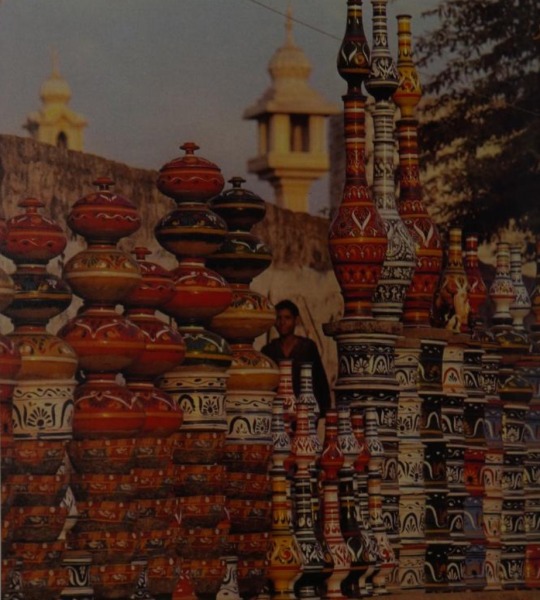
“Brightly painted pottery makes an eye-stopping splash of colour on a Taxila street. The bustling modern town with its handicrafts is in sharp contrast to the silent slumber of the 2,000-year-old ruins of the ancient eity nearby which was once a centre of learning and of Buddhist culture.”
From: “journey through Pakistan” by Amin, Mohamed; 1982.
23 notes
·
View notes
Text
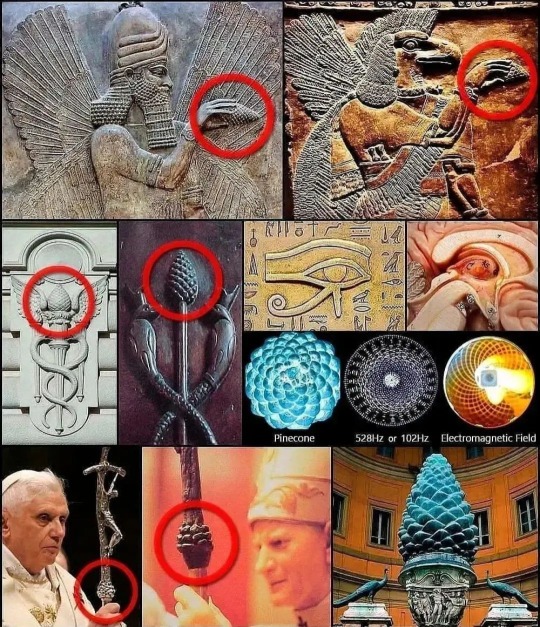
The pinecone is universally revered as one of the purest naturally occurring forms of Sacred Geometry, its pattern being the flower's evolutionary precursor, having its spirals in a perfect Fibonacci Sequence, much like the geometry of a rose or a sunflower.
ㅤ
This ubiquitous formation in nature is a common type of phyllotaxis pattern, from the ancient Greek phýllon "leaf" and taxis "arrangement", which refers to the set of principles that govern the arrangement of leaves along the stem of plants. But not only in the plant world, these same principles govern the configuration of cycles of harmonic vibrations at all scales of nature, including in our DNA and in the orbits of the planets.
ㅤ
The pinecone symbol is one of the most mysterious emblems found in ancient and modern art and architecture.
ㅤ
Few scholars realize this, but in different cultures the pinecone alludes to the highest degree of spiritual illumination, similar to the Lotus and Flower of Life symbolism.
ㅤ
The Pinecone symbol can be found in the ruins of Egyptians, Indonesians, Babylonians, Persians, Greeks, Romans, Buddhists and Christians. It also appears in the designs of esoteric traditions such as Freemasonry, Theosophy, Gnosticism and esoteric Christianity.
ㅤ
The pinecone symbolizes the science of light and its relationship with the mind and body through our pineal gland or "Third Eye", which represents the unified awareness that directs the evolutionary energy flow. The shape of the gland has a phyllotaxis pattern similar to that of the pinecone, hence its name Pineal Gland has its origin in the word "Pinecone".
31 notes
·
View notes
Text
OC Dani infodump

Long time coming for my friends in the Uncharted Discord, sorry it took forever
under the cut because there's a lot lol
"disclaimer" below:
okay first Dani is from my uncharted fanfiction series. originally started in 2016 my first story finished in 2017 where i had planned to make a sequel but didn't start it until this year. the original story and the sequel follow the events of Uncharted 4 and The Lost Legacy, the AU follows uncharted 4 during the prison in Panama but doesn't follow the same timeline.
go to resources:
the original story from fanfiction.net: (x)
part ii of the original story: (x)
new au: (x)
more about Dani including fanart drawn by other artists: (x)
photograph inspirations I used for Dani: (x)
me and a friend of mine back when uncharted 4 first came out helped me create Dani. note: we were two very mentally ill girlies, so a lot of the themes can get very heavy. a lot of trauma so trigger warning!
okay now onto Dani:
name: Danielle "Dani" Adler (married last name)
age: in the original story she's a couple years younger than Rafe, so in her early 30s. in the AU she is the same age as him, so born in the 1970s. (Rafe is estimated to be 35-38 in during the events of Uncharted 4)
ethnicity: Peruvian (mother's side) / Italian-American (father's side)
birthplace: around/outside of Pisac, Peru
zodiac (sun): Pisces
eye color: brown
hair color: dark brown/black
*Her parents met while her father was in Peru investigating the Inca ruins. Her father is how you'd describe Sully or Nate in the same profession.*
more random facts about Dani:
Dani is a martial artist practitioner of soo bahk do (she's a skilled fighter)
Not a good climber
Spanish is her first language, but she speaks multiple languages
She’s left handed
Missing her left ring and middle finger (original story)
Area of study: Ancient East Asian/Buddhist Art - also Inca Empire
how she got involved with the adlers
Dani's father, while decent at his job of artifact collecting, often had issues with biting off more than he could chew. coupled with gambling problems and double-crossing, he would find himself in hot water more than once. He was recruited by the Adlers for his expertise when Dani was a baby. The Adlers became his main clients, but he would borrow a lot from them, so a debt had to be settled.
My old friend and I are huge fans of Titanic, so picture Cal and Rose for this next part. Took heavy inspiration from their relationship in the movie without even realizing it at first lol.
Dani isn't given much choice and has to wed Rafe. Their marriage is more of a "business transaction" how I would describe it. Although they grew up together and do genuinely get along, there isn't exactly romantic feelings there.
In the main/original story they have two children.
Holden Adler (son, deceased)
Vera Adler (daughter)
What drove the final wedge in their marriage was the death of Holden. To put it briefly from one of the chapters in the story: He died tragically in an accident under Rafe's care. Dani fled hiding and becoming estranged. To protect her daughter her cousin Sophie has custody.
Their relationship in the AU will be a bit different.
Dani's personality:
indecisive
emotional
"unreliable narrator"
book smart
Those are the main words that come to mind while describing Dani. Obviously traumatized from different events in her life, she often has issues with regulating her emotions and cries easily. Most of her life has been out of her control so she often listens to others when they tell her to do something (within reason) and can be easily persuaded and can flip-flop.
She keeps peoples at arms length at first, but once she befriends them and builds a relationship she tends to give them the benefit of the doubt. Very empathic, she can feel when the tone and mood shifts without anything being spoken.
Since Dani was pretty much groomed into the thief/artifact seeker lifestyle, she specializes in that, specifically in ancient East Asian arts and history. She would go on "jobs" because she either had to pay off her father's debts or because the Adlers wanted their hands on something.
Her focus can also wane due to her traits of suicidal ideation and fear from scary loan sharks (amongst other things). Because of this she can be both physically and emotionally absent as a parent, especially after the death of Holden it was extremely difficult for her to cope.
In the original story and the sequel, Dani narrates the story from her point of view and leaves a lot about her past, her motives, and even keeps certain things like her children a secret from the reader and the characters in the story. That's why I labeled her as an unreliable narrator.
She’s currently living with her cousin and daughter in the Philippines, making being an active parent her main priority.
Dani's relationship with Sam:
Working on doing a more in-depth analysis of their relationship with the new AU.
Sam and Dani get along well from the start. Both emotional, they sometimes clash, but there's no denying their attraction to each other. Dani loves how he was able to find freedom in his life, and how passionate he is about Henry Avery (for example), and that he actually likes what he's doing, it's not a forced chore or just a job to him. Sam likes to flirt with Dani a lot, and she doesn't know how to really respond to it.
Unsure how to label their relationship, they kind of have a friends with benefits thing going on? Dani's convinced she has real feelings for him, but her lack of experience with actual healthy relationships might have her perspective warped.
in conclusion
Dani is a complex and deeply flawed character who experienced a lot of trauma, and doesn't often regulate her emotions in the healthiest ways. She is going through a lot of growth and is coming back mentally stronger than ever, the first step was finally cutting off her parents and making peace with Rafe (kinda) before his death (in the first story). In my original efforts to keep her as authentic/real as possible, and to prevent her from being a "Mary Sue" (super outdated term now that I don't agree with) I might have went a little too hard on displaying her weaknesses in an attempt to keep her more grounded. I had a lot of feedback from the community at the time that seemed in favor of this, so I kept going. I'm going to be taking a slightly different approach in the AU, but I'm going to keep her mostly the same.
I don't know what to say, I love flawed characters and Dani is my broken baby.
11 notes
·
View notes
Text
Until a decade ago, the pilgrims would travel by bus, car, donkey and foot to gather by the thousands at the Imam Asim Shrine in the desert on China’s western frontier.
They trudged through the sand dunes to kneel at the sacred site dedicated to Imam Asim, a Muslim holy man who helped defeat the Buddhist kingdom that had ruled here over a thousand years ago. The devotees were Uighurs, a mostly Muslim ethnic minority, and often joined annual festivals to pray for abundant harvests, good health and strong babies.
They tied strips of cloth carrying prayerful messages to wooden posts around and near the shrine. They delighted in fairground amusements on the site’s edge, where magicians, wrestlers and musicians entertained the crowds. They clustered around storytellers reciting ancient tales.
“It was not just a pilgrimage. There were performers, games, food, seesaws for the children, poetry reading, and a whole area for story-telling,” said Tamar Mayer, a professor at Middlebury College who visited the Imam Asim Shrine for research in 2008 and 2009. “It was still so full of people, and full of life.”
Even then the authorities were trying to limit the crowds at the shrine with checkpoints. By 2014, pilgrims had been almost entirely banned. And by last year, much of the shrine had been demolished. Wooden fences and poles that once encircled the tomb and held fluttering prayer flags had been torn down. Satellite images show that a mosque at the site was leveled. All that remained was the mud-brick building marking the tomb of Imam Asim, which appeared to be intact amid the ruins.
The Chinese authorities have in recent years closed and demolished many of the major shrines, mosques and other holy sites across Xinjiang that have long preserved the culture and Islamic beliefs of the region’s Muslims.
The effort to close off and erase these sites is part of China’s broader campaign to turn the region’s Uighurs, Kazakhs and members of other Central Asian ethnic groups into loyal followers of the Communist Party. The assimilation drive has led to the detention of hundreds of thousands in indoctrination centers.
The new report by the Australian Strategic Policy Institute, a research group based in Canberra, systematically gauges the degree of destruction and alteration to religious sites in recent years. It estimated that around 8,500 mosques across Xinjiang have been completely demolished since 2017 — more than a third of the number of mosques the government says are in the region.
“What it does show is a campaign of demolition and erasure that is unprecedented since the Cultural Revolution,” said Nathan Ruser, the researcher at the institute who led the analysis. During the decade-long turmoil that unfolded from 1966 under Mao Zedong, many mosques and other religious sites were destroyed.
The institute, also known as ASPI, compiled a randomized sample of 533 known mosque sites across Xinjiang, and analyzed satellite images of each site taken at different times to assess changes. It studied the state of the region’s shrines, cemeteries and other sacred sites through a sample of 382 locations taken from a state-sponsored survey and online records.
#current events#politics#chinese politics#racism#islamophobia#islam#uyghur genocide#china#xinjiang#uyghurs
15 notes
·
View notes
Photo

Tocharians, an ancient Indo-European people that settled in what is today north-western China. Their languages are preserved in over 7000 manuscripts, mostly translations of Buddhist scriptures, found in caves and ruins of monasteries in the Tarim desert. They were assimilated by the Uyghurs by about the 13th century.
11 notes
·
View notes
Photo

June 2011 KTM Kathmandu Nepal Road to Lumbini
Sagarhawa Lake Historical Lake Sagarhawa Kapilbastu Lumbini Zone
http://bit.ly/3USKG8d
© KOJI ARAKI Art Works
Daily life and every small thing is the gate to the universe :)
#2011#June 2011#ktm#kathmandu#nepal#Road to Lumbini#Lumbini#2nd day in Lumbini#the 2nd day#Sagarhawa Kapilbastu Lumbini Zone#Sagarhawa#ancient buddhist ruins#ancient buddhist landmark#sky#cloud#photographers on tumblr#b&w photography#black and white photography#original photography#photography#koji araki art works#PENTAX K10#SIGMA 15mm 2.8 EX Fisheye#Fisheye#SIGMA#PENTAX
68 notes
·
View notes
Text
Best travel destinations to visit 2024
Top best places to must to travel :
Bhutan: Land of Happiness: Nestled amidst the majestic Himalayas, Bhutan beckons with its enchanting landscapes and vibrant cultural heritage. As one of the world's happiest countries, Bhutan offers travelers a unique opportunity to immerse themselves in the tranquility of Buddhist monasteries, hike through pristine mountain trails, and witness traditional festivals that celebrate the rich tapestry of Bhutanese culture.
Croatia Adriatic Gem: With its azure waters, picturesque islands, and charming medieval towns, Croatia continues to captivate travelers seeking a Mediterranean escape. From the historic city of Dubrovnik, known as the "Pearl of the Adriatic," to the idyllic islands of Hvar and Korčula, Croatia offers a perfect blend of history, culture, and natural beauty.
Japan: Land of Contrasts: From the bustling streets of Tokyo to the serene temples of Kyoto, Japan is a land of captivating contrasts. In 2024, travelers can discover the country's rich cultural heritage, sample delicious cuisine, and marvel at the beauty of cherry blossoms in bloom. With the upcoming Tokyo Olympics, Japan promises to be a vibrant destination filled with excitement and cultural festivities.
Peru: Land of the Incas: Home to ancient ruins, breathtaking landscapes, and vibrant indigenous cultures, Peru offers travelers a journey through history unlike any other. Explore the iconic Machu Picchu, trek through the Sacred Valley, and savor the flavors of Peruvian cuisine in Lima, known as the gastronomic capital of South America.
Iceland: Land of Fire and Ice: Renowned for its otherworldly landscapes, Iceland is a paradise for nature lovers and adventure seekers alike. From the dramatic waterfalls of Gullfoss and Skógafoss to the steaming geothermal springs of the Blue Lagoon, Iceland's raw beauty never fails to mesmerize visitors. In 2024, travelers can also witness the awe-inspiring spectacle of the Northern Lights dancing across the Arctic sky.
Australia: Land Down Under: From the sun-kissed beaches of the Gold Coast to the rugged beauty of the Outback, Australia offers endless opportunities for exploration and adventure. Discover the vibrant city of Sydney, snorkel the Great Barrier Reef, and embark on an unforgettable road trip along the scenic Great Ocean Road.
Portugal European Gem: With its charming cities, picturesque coastline, and rich cultural heritage, Portugal is a hidden gem waiting to be discovered. Explore the historic streets of Lisbon, wander through the vineyards of the Douro Valley, and relax on the sun-drenched beaches of the Algarve. In 2024, Portugal's warm hospitality and laid-back charm await travelers seeking an authentic European experience.
Morocco: Gateway to Africa: Immerse yourself in the exotic sights, sounds, and flavors of Morocco, where ancient traditions blend seamlessly with modern influences. Explore the bustling souks of Marrakech, wander through the labyrinthine streets of Fez, and embark on a desert adventure to the Sahara dunes. With its vibrant culture and diverse landscapes, Morocco offers a truly immersive travel experience.
New Zealand: Land of Adventure: From rugged mountains to pristine beaches, New Zealand is a playground for outdoor enthusiasts and adrenaline junkies. Discover the breathtaking landscapes of Fiordland National Park, hike the legendary Milford Track, and experience the thrill of bungee jumping in Queenstown, the adventure capital of the world.
Greece: Cradle of Civilization: Step back in time and explore the ancient wonders of Greece, where mythology comes to life amidst stunning archaeological sites and sun-drenched islands. Discover the iconic Acropolis in Athens, sail the crystal-clear waters of the Aegean Sea, and indulge in delectable Greek cuisine overlooking the Mediterranean sunset.
In conclusion, the year 2024 promises a wealth of exciting travel opportunities for adventurers of all kinds. Whether you're drawn to the cultural heritage of ancient civilizations, the natural beauty of remote landscapes, or the vibrant energy of bustling cities, these ten destinations offer something for every traveler seeking to make unforgettable memories and embark on a journey of discovery.
Read more
2 notes
·
View notes
Text
WiP Wednesday: The Seduction of the Innocent
Okay, firstly, this entire idea is really the brainchild of myself and steveelotaku and we’ve had fun coming up with stuff for it. The title is his suggestion - based on that crackpot book written about Batman and Robin being gay and corrupting the youth of America. It’s PERFECT for a fic that is all about Zuko writing a comic strip to help support his thesis as he goes to Ba Sing Se University lol
Premise: Zuko needs a hobby to keep himself occupied during the idle times of teaserving/vigilantism - and ends up writing. His new BFF Jin also suggests that he apply for Ba Sing Se University when his history of researching the Avatar and their cultures comes out. So Zuko ends up writing a thesis that studying ancient/declining cultures (Air Nomads and the Water Tribes) is worthwhile in the world today (bc the Water Tribes still exist and there’s 1 living Air Nomad). To help make his point/spread knowledge about the different cultures, he and Jin end up creating a comic series about The Adventures of the Blue Spirit and the Avatar (and co). Through the hijinks of the Blue Spirit and the Avatar traveling around the world (remember, there’s no war in Ba Sing Se), they fight crime and evildoers and teach each other about their cultures.
So, right now I’m thinking this is actually 2 fics: a prequel and a sequel. The prequel will be all about establishing Zuko going to Uni and creating the comic and some of its effects (it’s REALLY popular with kids!). The sequel is when the Gaang (Zuko coined the name) finds out about the comics and read them - and then Aang, who KNOWS who the Blue Spirit is, goes looking for the author to confront them. He suspects it’s Zuko, but he doesn’t actually BELIEVE that it’s really Zuko. After all, how could ZUKO get into Ba Sing Se and why would he write comics explaining how the Air Nomads believed in peace?
(For those that dislike shipping in atla, the sequel will have some Zuko/Aang, but probably T-rated teens dating. Not wholly sure yet, but I think the whole series will be T)
So far, I have a few random scenes written, so I’ll share some snippets here, but also, I HAVE to tell you about what steveelotaku came up with for the comic!!!
The Comics
So like I said, the premise of the comics is: the adventures the Gaang + the Blue Spirit get up to, while fighting off their standard array of villains. (Credit for these goes to steveelotaku, who is incredible and came up with GREAT villains!)
The Big Bad: Fire Lord Ozai
But, I hear you say, there’s no war in Ba Sing Se! So how-?
Well, the answer is - Zuko REALLY wanted to draw his dad receiving a pie to the face (look, he’s upset about the whole traitor thing and he needs an outlet) from Aang, so he invented a silly Silver Age Comics campy reason for why the Fire Lord hates the Avatar: the Avatar blew storm clouds over his parade and RUINED his hair! (Ozai hates getting wet 😂)
Other Recurring Villains:
Sparkler, the Princess of Pyromania: Fire-themed villain with a mysterious connection to the Blue Spirit and a grudge against them
The Koan: Basically Buddhist Riddler. "What is the sound of one hand picking your pocket?" "If a building blows up, and no one is around to see it, did I commit a crime?"
The Cabbage Merchant of Death: Literally just the cabbage merchant, but breeding his cabbages to attack humanity as vengeance for overturning his cart. (The Cabbage Merchant actually loves the comics and his portrayal. Someone recognized his plight! So he taped one of the panels to his cart.)
The Tapestry: Literally a guy dressed in a tapestry who makes horrible weaving jokes and uses sharp threads. "Knit one, purl-oin two gold bars!"
The Ember Island Jester: The only actor to be fired from the Ember Island Players, because his jokes were terrible. His crimes are all theater-themed and he wears a comedy mask. "Four nations, all alike in dignity, all ripe for the plundering!" "It's curtains for you, Blue Spirit! -drops a heavy curtain on him-"
The Nightingale: Basically the Penguin, but with an army of robot nightingales, like in the old Chinese fable about the Emperor who forgot how a nightingale had brought him joy when a mechanical one is given to him, only for it to save him later. Only this time, the Nightingale is some minor noble who got fired and now keeps pestering Ozai with his robot nightingales and Ozai has to call for the Blue Spirit, much to his frustration. "The Nightingale sings the song of your doom!" Aang: "How does that go?" "Uh...doom! DOOM DOOM DOOM! DOOM doom DOOOOOM!"
Okay, so those are our Villains. Now what about our heroes? Remember, the Gaang is being written by Zuko - who may do lots and lots of research and maybe has stalked them on occasion, but still doesn’t really KNOW them.
The Blue Spirit - Zuko goes in hard on the tropes, so the Blue Spirit is totally the broody badboy. He has a secret identity that no one knows. Also, he tells tea jokes and makes tea puns. Iroh is very proud.
Aang, The Avatar - Aang is the epitome of “peace, love, and happiness make the world go round” (real Aang finds this hilarious) but he’s also an incurable prankster
Toph, The Avatar’s Earthbending Teacher - Toph is the buffest, littlest character there is and it is unclear whether she beats villains with her bending or her fists or if the two are one and the same.
Katara, The Avatar’s Waterbending Teacher - Katara is the scariest motherfucker on the team and Zuko stands by that. She has some of the corny “hope” lines, complementing Aang, but mostly, it’s her determination that makes her scary. When she decides something, it happens. (Zuko might be projecting a bit, but he’s not wrong.)
Sokka, The Avatar’s Jester/Strategist - Sokka is the straight forward comic relief and is a walking joke, but he does tend to suggest the plans that work... they’re just very, very ridiculous, in line with Silver Age comics ridiculousness.
And some choice lines by steveelotaku:
"Holy cumulus, Blue Spirit! The Fire Nation's set fire to the tea tree grove!"
"The fiends! It's not enough for them to boil it too long--now they're roasting it to ashes!"
"Halt, Blue Spirit! Your pathetic crusade of justice stops here!"
"It's that suspicious sous-chef of sabotage, Serial Griller! Fire Lord Ozai's right hand cook!"
"That's right, Blue Blunder! And today's special is deep fried masked man with a side of Avatar fries!"
"Blue Spirit! Help!"
"By the subtle tang of oolong tea! Avatar, you're turning into a were-bison!"
Not a trick! Not an imaginary story! The Avatar's best friend might just be his doom! Can Aang and the Blue Spirit survive...THE NIGHT OF THE APPA-LLING WERE-BISON?!
AND NOW, THE SECRET ORIGIN OF THE BLUE SPIRIT:
A nameless warrior stands on the battlefield in the pouring rain. Another village massacred, the survivors left for dead. He alone had dared to speak against this heinous crime, and for that he was cast out from the only family he had. Hiding within a teahouse, he took with him the one souvenir of that battle he dared to claim--the mask of the Blue Spirit, a warrior who had fought for justice against his cruel oppressors. Now, the warrior takes the mantle for himself--to find redemption, or die trying!
Snippets:
The Beginning
Zuko needed a hobby, was the thing. He was really, really busy in Ba Sing Se, between being a tea server and being the Blue Spirit. But there was a lot of idle time in both roles and Zuko just needed something to keep him occupied. It wasn’t supposed to turn into a big thing.
Only one day, Jin had caught him writing at the teashop and demanded to read it and… look. It was just a lark. It was just a funny little idea that he was toying with. It didn’t mean anything.
It was in the afternoon lull and Uncle was, fortunately, in the backroom, doing tea things. Meanwhile, Zuko’s only other customer was an old accountant who was always buried in their books and never registered anything going on around them. They liked Pao’s strongest tea.
This meant that there was no one else around to see the look on Jin’s face when she read through his scrawled handwriting – he was much better at writing with a calligraphy brush, but these days, charcoal was as good as it got – depicting a silly dialogue exchange between the Blue Spirt and the Avatar. It was just one of the questions he’d always wanted to ask the Avatar, one that wasn’t really important, but that had bothered him until he’d researched it anyway.
“Li,” she said slowly.
Zuko gulped. “Yeah?”
“This… this is good,” she said with a tone of wonder. “Seriously, I really like this!”
“You… do?” Zuko blinked, not sure what to do with that. “But it’s – it’s–”
“Funny? Enjoyable? Cute?”
“Dumb.”
“Bullshit,” Jin said bluntly. “You’re allowed to enjoy dumb things, Li. As long as it’s fun, what else matters?”
Zuko frowned. That was not a philosophy about life that he was familiar with.
“Do you think the Avatar really throws pies in people’s faces?” Jin asked with a laugh.
“Oh, that bit I can confirm,” Zuko flashed a brief grin. “I found a letter from the King of Omashu to the Southern Air Temple that very specifically said Aang and his friends had pie’d the King’s Guard.”
Jin blinked. “What do you mean, you found a letter?”
“Oh,” Zuko bit his lip, realizing he really shouldn’t have said that. “I, um. I… studied the Avatar. For a long time. And the Air Nomads and the Water Tribes, a little bit.”
“Really?” Jin looked excited, of all things. “That’s so cool! So you were a mini scholar before tragedy struck, huh? Are you gonna try to apply for Ba Sing Se University? You should!”
“I… what?”
“It’s not often someone from the Lower Ring gets accepted,” Jin said, “but it does happen! And I know you’d study really hard and there are scholarships and things to help pay for it. You should try!”
“I’ll… think about it?” Zuko said, taken entirely off guard.
“You should write more, too,” Jin encouraged. “Honestly, it’s a really fun scene. I kinda wanna draw it.”
Jin’s family ran what was probably one of the best places in town to get writing and illustration done on a budget. This meant that Jin spent a lot of time drawing what she called ‘very boring adverts’. He wouldn’t think his scene was that interesting either, but Jin’s face was genuine and she smiled at him.
“Really?” he couldn’t help but ask.
“Yeah, absolutely,” Jin grinned, “just the visual of the Fire Lord getting a pie in the face–” she broke down laughing.
Zuko flushed. It was possible he was a bit upset with his father for marking him as a traitor and sending his sister to bring him home in chains. And it wasn’t like a little pie had ever hurt anyone…
During Zuko’s Tour of Ba Sing Se University (from the POV of the admissions tour guide)
“As part of your curriculum. You don’t study other cultures, like the Water Tribes and the Air Nomads?”
There was a loud scoff from behind Min and she turned to see Professor Lang sneering down his nose at the kid.
“Of course not,” he said. “What use is there in studying ancient civilizations?”
The kid looked confused for a brief moment… and then he got mad, and wow, he was actually kind of scary underneath that scruffy unkemptness.
“The Water Tribes aren’t dead! And even if the Air Nomads are, there’s still reason to learn about them!”
“And what, pray tell, would that be?”
The kid had a pretty impressive snarl. “The Earth Kingdom has trade contracts relating to the Water Tribes, who are still alive. And there’s one living Air Nomad now, too!”
Min blinked. What did that mean?
“Pah,” Professor Lang spat. “The Avatar is not part of any culture.”
The what?
“The Avatar isn’t told until they turn sixteen. Until that age, Avatar Aang was and still is an Air Nomad.”
What!?
“The… Avatar?” Min said vaguely. How had she not heard about this? “The Avatar is back? And they’re an Air Nomad!?”
The kid looked scared for a moment. Perhaps he could sense how closely they danced to the dangerous territory of current events.
“Yeah,” he said slowly. “We, um. We heard before coming to Ba Sing Se that the Avatar is back. And – and he’s an Air Nomad. So there’s relevance in understanding the Air Nomad culture! Because, like…” he visibly flailed for an example that would be acceptable, “like family!” He held up his finger triumphantly. “Culture affects what words mean. In the Earth Kingdom, family is defined as your clan, tied to you through blood, marriage, or contract. In the Water Tribes, the whole tribe is family and everything is done in service to that family. But to the Air Nomads? They defined family as people chosen based on who you wanted in your life. They did not recognize blood ties.”
Min and Professor Lang both stared at the kid.
“How – how do you know that?” Professor Lang asked eventually.
The kid froze. “I, um. I did a lot of research on – on the Avatar and, and their cultures. I’m not making it up! One of their core tenets was that the blood of the covenant was thicker than water of the womb, meaning those who share their vows are more kin than those who share their blood. They were more concerned with spirituality and behavior.” The kid sighed heavily. “I wish my old library hadn’t burned. I had some amazing finds.”
Min’s eyebrow arched. That almost made it sound like, despite the current state of things, this kid had some noble background. Well, well. That changed things.
She clapped her hands together. “This sounds like an excellent topic for a thesis, don’t you agree, Professor Lang?”
“A – what?”
“A thesis, of course. You have an argument to make – that ancient/declining cultures still have a role in our society. Through your course of study here at Ba Sing Se, you will learn how to draft an effective argument, backed by primary sources.”
“I had primary sources!” the kid said, sounding strangely offended.
“Of course,” Min allowed.
“You want this disrespectful brat to write a thesis on such an absurd topic!?” Professor Lang burst out.
“He argued his point well, did he not?” Min shrugged, smiling pleasantly.
“I have another one,” the kid – Li, according to her file – said. “The Air Nomads were pacifists. They didn’t believe in consuming the flesh of any creature, because in their view, violence was abhorrent in any form. So think about it… the – the Avatar’s job is to bring peace and balance to the world, right?”
Min took a sharp breath. That was coming a little too close to–
“Well, Air Nomads were very devoted to peace. They have eighty-seven words for peace, all of which mean different things. Some of which, if applied to the nations by the Avatar, would face significant dissent. So in dealing with the Avatar, it’s important to know that you need to clarify the meaning of things being discussed.”
“And you expect to be ‘dealing with the Avatar’, do you?” Professor Lang sneered.
Li opened his mouth, closed it, then opened it again. “Of course not,” he said, “but that’s precisely why the study of these cultures is so significant! Because if it’s not widespread knowledge, then we’re all at a disadvantage.”
Min clapped, “well said. What is knowledge but a tool for the betterment of ourselves?”
“...right,” Li nodded hesitantly.
(For those curious, Professor Lang knows about Aang because the Gaang and Joo Dee went by the university when they first came to Ba Sing Se - but the visit was kept moderately hush hush, because talking about the Avatar can mean talking about the war. This changes when the comic takes off.)
From the next scene
Jin was pacing in Pao’s Teashop as they all waited excitedly to hear the results of Li’s visit to the university. Mushi was channeling his anxiety into making lots of tea, so Jin was spending far more than she should on new pots, but at least sipping tea gave her something to do.
Finally, Li opened the door – and jerked back as everyone in the teashop – four of the afternoon regulars and Jin, plus one couple that had no idea what was going on – rounded on him.
“Well? How did it go?”
“Uh.” Li scratched his head. “I think I’m a student now?”
Jin blinked. “I thought you were just going to apply?”
“So did I,” Li shrugged. “And then I got into an argument with a professor during the tour–”
Everyone groaned collectively.
“Oh, Nephew,” Mushi sighed, coming out from behind the counter and ushering Li into the room.
“Of course you did,” Jin laughed.
“But it was fine,” Li huffed. “In fact, I think it actually helped me? I guess I’m writing a thesis on the Avatar and also why studying other cultures matters?”
“You’re… what?” Mushi said blankly.
Li shrugged helplessly. “It just kinda happened.”
Now we skip waaaaaaay ahead to the sequel, to when the Gaang (well, Aang specifically) finds out about The Adventures of the Blue Spirit and the Avatar
It started with an innocently overheard conversation at a bakery near their Upper Ring house while waiting for the new pies to cool.
“Did you read it?” one girl hissed to another. “Did you see!?”
“Yes!” the second girl sounded so excited that it was hard to control her volume. “I told you! It’s real! Spiritar is canon!”
“I just can’t believe it,” the only boy amongst the group murmured. “I didn’t see it coming at all.”
“That’s because you never listen to us,” the first girl sniffed. “I called the Blue Spirit x Avatar Aang coming from miles away.”
The… what?
Aang blinked, turning to stare at them. “I’m sorry, did you say Avatar?” he asked hesitantly.
“Yeah, who’s asking – oh sweet spirits, it’s the Avatar!” the boy looked like he was about to hyperventilate.
“Um. Hi,” Aang waved awkwardly.
The two girls squeaked and flushed red. “Hi,” they managed, one more easily than the other.
“Did you say something about – about the Blue Spirit and the Avatar?”
“Oh spirits,” the second girl whispered under her breath. “Oma and Shu, why would you do this to us?”
“Um?”
“Okay, so,” the first girl cleared her throat. “Um, let’s start at the beginning. Are you familiar with The Adventures of the Blue Spirit and the Avatar?”
“The… huh?” Aang’s mouth twisted in confusion. Who was the Blue Spirit and what did they have to do with him?
There was a cleared throat from next to them and another woman in the bakery stood behind them. “Hi, I’m sorry, I couldn’t help but overhear and – I have a binder just for this purpose.” She pulled out a thick binder full of papers and thudded it down on the table. Then she opened it to a page that had two figures cut out from an inked illustration. One was obviously Aang, though his arrows weren’t quite that big – but the other… the other was–
“The Blue Spirit, you called them?” Aang asked, staring at the mask that he remembered with stark distinction. If the stranger in the mask hadn’t saved him…
But then, of course, the stranger turned out to not be so strange after all. Aang could still feel the rough bark under his fingers as he played with it, waiting for Zuko to wake up.
If we knew each other then, do you think we could’ve been friends? he’d asked, and Zuko hadn’t actually answered, but the blast of fire spoke many words.
“You don’t know them?” the girls all looked up at him with a broken sort of hope.
“I – I do,” Aang answered hesitantly. “But I never got their name.”
“Yes!” two of them high fived and Aang just stared at them. “Uh, sorry.”
“Anyway,” the girl with the binder said, “The Adventures of the Blue Spirit and the Avatar, originally simply titled the Blue Spirit, is a serial comic created by Li and Jin. They’re two artists in the Lower Ring, if you can believe that. But Li attends Ba Sing Se University!”
“Uh. Okay?”
She cleared her throat, flushing. “Um, at any rate, the comics are aimed at children and Li has been recorded as saying that he wanted to explain cultural differences through a fun story. And they deliver! The characters are great, the dialogue is snappy, the illustration is beautiful, and the plots are silly but fun.”
“Nothing will ever top the Fire Lord getting pie’d in the face, though,” the first girl said nostalgically.
“What?” Aang asked.
“Oh, I have that in my binder!” The girl flipped through several pages and landed on a comic panel pasted onto the paper. It depicted – exactly what they said. Fire Lord Ozai – who Aang had never actually seen in person, but he had seen a few paintings and it looked pretty accurate – receiving a cream pie to the face. Actually, the pie was drawn pretty well, too – it even had the lemon curd filling that Aang and Master Gyatso used to add for extra gooeyness.
That was surely just a coincidence, though. Right? It wasn’t like the Blue Spirit could really be–
“It’s a really famous picture now,” the girl with the binder whispered to Aang. “It’s the only thing like it that hasn’t been censored by the Dai Li. See, in The Adventures of the Blue Spirit and the Avatar, the Fire Lord has a legitimate reason to hate the Avatar.”
…was stopping him from destroying the world not legitimate?
“Oh?”
“Oh, I love this one. Show him the comic strip!”
“Here it is!”
Aang looked down to see a single panel of Fire Lord Ozai, this time wailing, “my hair!”
“Uh…”
“The Avatar was flying a kite,” one girl explained, “and he was messing with the wind currents – but it made storm clouds fall on the Fire Lord’s parade and ruined his hair!” They all chortled. “Literally you rained on his parade!”
Aang… did not know how to react to that.
“So anyway, the Avatar and his friends join the Blue Spirit and fight crime and evildoers!”
“Yeah, the Blue Spirit is a vigilante, you know that, of course,” one girl said and actually, Aang had not known that. “So they team up with the Avatar and with the whole Gaang–”
“Pardon?”
“Oh yeah, isn’t it great? It’s ‘gang’ but with 2 ‘a’s, like your name! To encompass all of you together!”
Aang hummed. He did like it, actually. Sokka would be upset that he hadn’t come up with it.
Especially if the person who did come up with it was really–
But surely it couldn’t be. How would Zuko have even gotten into Ba Sing Se?
From the confrontation between Aang and Zuko after Aang tracks down the creators of the comics (with some shippiness)
“Soooo,” Jin drawled, sprawling in a booth in the otherwise empty teashop, “guess what happened today?”
Zuko, busy wiping down a table, didn’t answer.
“C’mon, guess! It’ll interest you, I promise.”
“I dunno. You… had an idea for a comic?”
“That happens every day, Li,” she said flatly.
Zuko sighed. “Just tell me.”
“Fine, fine,” Jin paused, making him wait, and then she burst out, “the Avatar came by the shop!”
Zuko froze, blood draining from his face. The Avatar. The Avatar was here. The Avatar was here and knew about the comics, elsewise why would he have gone to Jin’s family’s shop?
Oh, this couldn’t be good.
“Li? You okay?”
Before Zuko could answer – negatively – the door to the teashop opened and the Avatar walked inside.
Zuko wanted to die. This was it. This was the end of him. This was when his cover would get blown and everyone would know and hate him and–
“Hi,” Aang greeted them pleasantly. “I’m looking for Li.”
Zuko just about swallowed his tongue. There was no way that Aang had failed to recognize him. The change in hairstyle did not make up for the huge disfiguring scar.
Raising a shaking hand, Zuko managed a strangled, “I’m Li.”
The Avatar smiled. What even–?
“I thought it might be you,” Aang said. “But I also kind of thought I was probably wrong.”
Not having any idea what to say, all Zuko could do was swallow drily.
“Huh,” Jin said, “you really have met the Avatar.”
Zuko flushed. “I told you!”
“You say lots of things, though,” Jin contested. Usually, Zuko was grateful that she let his slip ups go so easily, but right now, he was just annoyed.
“I don’t lie,” he frowned. That was a rule for him. His whole identity may be a lie, but at least he would do his best to live honorably.
Aang coughed and Zuko flushed brighter, jerking his attention back to the man who, technically, was still his enemy.
“Sorry,” Jin laughed, holding out her hand, “hi, I’m Jin. I hear you went by my family’s shop earlier looking for us?”
“You’re the illustrator?” Aang asked.
“Yep, that’s me!” Jin beamed, showing off her chipped teeth.
“Wow. You do a really good job of showing different places,” Aang complimented and Zuko stared. What was even happening?
“Oh, that’s all thanks to Li,” Jin demurred. “Sometimes I dunno whether his descriptions are accurate or not, but he believes in them so much that it just seems right to go with it.”
Zuko groaned, slapping a hand to his face. “Jin…”
Aang smiled wider and it made Zuko’s heart pound, cheeks turning pinker. “Well, you both create very good comics,” Aang said casually, as though Zuko wasn’t close to expiring on the spot.
“You – you read them?” Zuko croaked.
“Of course,” Aang said. “We had to see what was being written about us!”
Oh. Great. So all of Aang’s friends had read them. Fuck.
Oh Agni, did that include the most recent issue? Maybe he was lucky for once in his life and it didn’t–
Aang pulled out a comic and the cover was quite familiar. Jin had drawn the Blue Spirit in the middle in a ridiculous pose that really emphasized his butt – even moreso than the original draft, because Jin was an asshole and made the change after he complained. Behind the Blue Spirit were various headshots of the Gaang – Zuko came up with the name and he was rather proud of it – with little hearts all around them.
The cover proclaimed, ONE OF THESE PEOPLE IS THE BLUE SPIRIT'S SOULMATE – BUT WHO!? and the story was all about one of the regular villains, Sparkler – who totally wasn’t Azula – trying to find the Blue Spirit’s lover to blackmail him. After she was defeated, the true lover was revealed… with a kiss, because of course it was.
Zuko felt like he might cry at the absurdity of this being how his life falls apart (again).
“Sooooo, um…” Aang started and Zuko could not look at him.
“In my defense,” Zuko started, his mouth absolutely disconnecting from his brain, “it was a reader request.”
Aang tilted his head. “What does that mean?”
“Oh, you don’t read the letters at the end of the issue?” Jin asked, “you really should, they’re quite fun. We answer questions and requests from readers – mostly kids, but sometimes their parents, too.”
“And a kid… asked about–?”
Zuko just nodded mutely, but Jin – the traitor! – explained, “they asked about who the Blue Spirit’s soulmate would be. And obviously – ow!” Zuko elbowed her hard in the side, but it was too late. Aang’s eyebrows were high.
“‘Obviously’?”
“I mean, have you read the flirting?” Jin asked. “Li writes fantastic banter, doesn’t he?”
“Fucking hell, Jin, shut up!” Zuko hissed, and he was sure that his face was hot enough to be steaming. Hopefully Jin wouldn’t question it.
“Oh, all right, all right, I’ll let you two talk alone. But don’t forget the afternoon rush will be soon!”
So saying, Jin sidled out the door, headed back to work. The Avatar opened his mouth as soon as she was gone and Zuko quite abruptly wanted her back. He scrambled around for a change of topic and grasped the teapot next to him.
“Tea! Would – would you like some tea? We have–”
“I liked the tea jokes in the comics,” Aang said calmly. How was he calm when Zuko was about to shake out of his skin?
The pottery clattered slightly from his trembling hands, but he served Aang a cup of jasmine tea. “Those mostly came from Uncle,” he murmured.
“Well, they were fun,” Aang said, taking the cup and immediately sipping it as though it hadn’t been poured by his enemy. Then he smiled. “Jasmine. I like jasmine. It was my mentor’s favorite.”
“I know,” Zuko said without thinking.
“You… know?” Aang blinked. “How?”
“Uh.” Oh Agni, how was he supposed to explain this. “One of the Elders at your temple kept a journal. It survived.”
Aang stared. “Seriously?”
“Yeah,” Zuko nodded. “Monk Tashi. He complained about how often you got into trouble and how Monk Gyatso only encouraged it.”
Aang inhaled sharply, breath hitching at Gyatso’s name. Zuko could only imagine how much the loss hurt him. If Zuko ever lost Uncle…
Okay, that’s all I got, but I’m very excited for this series, so I hope you enjoy!
27 notes
·
View notes
Text
Lingshan Hermit: The 155-year-old mousetrap that can still catch mice and the Diamond Sutra that can still benefit sentient beings after 1600 years
In a rural cultural museum in the UK, something astonishing happened one day that left the managers dumbfounded. A mousetrap that had been an exhibit in the museum for over 100 years somehow caught a mouse. Since it lacked food after being caught, the mouse starved to death inside. The news reported that the museum decided to preserve the mouse as a specimen and place it back inside the mousetrap for visitors to see. Ordinary people might say this mousetrap is too amazing - it can still catch mice after over 100 years. The quality is truly remarkable. However, my train of thought is a little different from yours.
As we live in this world, everyone does things that leave traces and impact both your future and that of others. According to Buddhist teachings, every minute and every second we are arranging our own future - your present is also arranged by your own hands in the past. Our three karmic doors of body, speech and mind are continuously creating good karma, bad karma, or neutral karma, depending on our motivations. If not destroyed or weakened, these karmas will ripen at some point in the future. Anything we do will inevitably affect others. There is an ancient Chinese saying that goes: "Previous generations plant trees for the later generations to enjoy the shade."
It is said that the mousetrap which caught the mouse already had 155 years of history. Now it is 2016 AD. We can imagine that in 1861, an artisan at the Colin Pullinger & Sons company in the UK made this mousetrap. They put their heart and soul into making it perfect, so perfect that it could still harm sentient beings even in 2016. That artisan who was responsible for making it, even though he may have reincarnated many times, is still accountable for this. Some imaginative Buddhists might even speculate that the mouse was the reincarnation of that artisan. In contrast, about 1600 years ago (around the same time the Xiongnu people were busy invading Europe and the Roman emperor made an important decision - to make Christianity the state religion), in the East there was a gifted monk called Kumarajiva. He spent his whole life translating countless Buddhist scriptures, the most famous being the Diamond Sutra in Chinese. Even today, countless people recite the Chinese Diamond Sutra and accumulate merit. Throughout history, countless masters have attained enlightenment from reciting the Diamond Sutra. Countless people have reduced or eliminated harmful acts towards sentient beings because of reciting the Diamond Sutra.
Which kind of person do you want to be? If we had a choice, we should never be the kind of person whose creations can still harm sentient beings 155 years later. The scientific giant Einstein was plagued with long-term unease for participating in the development of nuclear weapons in the US, because he could foresee the harm they would inflict on humanity. Upon seeing the atomic bomb test scene, he exclaimed: we have unleashed the devil. He kept finding excuses to reassure himself, but I believe he was never fully at ease about it until his death. Even today, we have all seen from the media the harm nuclear technology has caused humanity, from Hiroshima to Chernobyl to Fukushima - the deformed babies at birth, the mutated animals, the abandoned and uninhabitable ruined cities.
The 155-year-old mousetrap that can still catch mice and the Diamond Sutra that can still benefit sentient beings after 1600 years are both results of human intellectual activities. They represent two different choices that lead to two different futures.
This article was first published on Lingshan Hermit's Sina blog on April 30, 2016.
Copyright Notice:All copyrights of Ling Shan Hermit's articles in Simplified and Traditional Chinese, English, and other languages belong to the natural person who owns "Ling Shan Hermit". Please respect copyright. Publishers, media, or individuals (including but not limited to internet media, websites, personal spaces, Weibo, WeChat public accounts, print media) must obtain authorization from Ling Shan Hermit before use. No modifications to the articles are allowed (including: author's name, title, main text content, and punctuation marks). We reserve all legal rights.
灵山居士:155年后还可以抓老鼠的捕鼠器与1600年后还可以利益众生的金刚经
6 notes
·
View notes
Text
7 UNESCO Heritage Sites of India by Bright Holidays
Introduction:
India is a country with a lot of different cultures, a long and interesting history, and beautiful natural scenery. It has many places that tourists from all over the world find interesting. Whether it’s amazing buildings or places of worship, India’s tourist spots provide a wide range of experiences. Here, Bright Holidays presents a curated list of seven UNESCO World Heritage sites that encapsulate India’s unique charm.
UNESCO World Heritage Sites of India:
1. Taj Mahal:
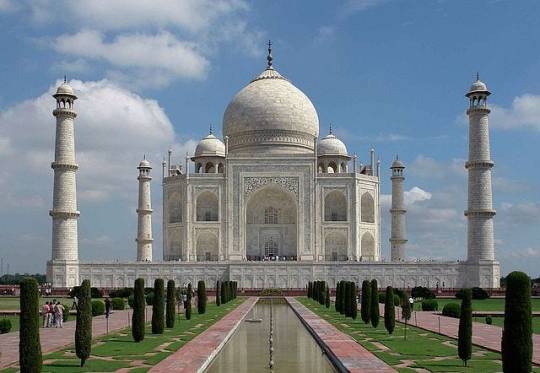
Undoubtedly one of the most iconic symbols of India, the Taj Mahal stands as a testament to eternal love. Located in Agra, Uttar Pradesh, this pristine white marble mausoleum was commissioned by the Mughal Emperor Shah Jahan in memory of his beloved wife, Mumtaz Mahal. Its intricate architecture, intricate carvings, and the mesmerizing play of light during sunrise and sunset make the Taj Mahal a must-visit destination for any traveller.
2. Red Fort:

Situated in the heart of Delhi, the Red Fort, or Lal Qila, is a historic fortress that served as the main residence for Mughal emperors for nearly 200 years. Constructed using red sandstone, the fort is a remarkable blend of Persian, Timurid, and Indian architectural styles. The Red Fort hosts the annual Independence Day celebrations of India on August 15th.
3. Champaner-Pavagadh Archaeological Park:

Located in Gujarat, this UNESCO World Heritage site encompasses the archaeological remnants of a medieval capital and the hill fortress of Pavagadh. Recognized in 2004, it showcases a harmonious blend of Hindu-Muslim architecture and culture. Highlights include the Jami Masjid and intricately carved temples on Pavagadh Hill, offering a glimpse into the historical and cultural significance of this unique site.
4. Qutab Minar:

Delhi, with its rich history, is home to the Qutab Minar, the tallest brick minaret in the world. Built-in the 12th century, the Qutab Minar complex includes various historical structures and ruins, such as the Iron Pillar of Delhi. The intricate carvings on the minaret narrate the history of its construction and the dynasties that ruled over Delhi.
5. Konark Sun Temple:

Located in the state of Odisha, the Konark Sun Temple is a mesmerizing architectural marvel dedicated to the sun god Surya. Built in the 13th century, the temple is renowned for its intricate stone carvings that depict scenes from daily life, mythology, and the celestial world. The temple’s chariot-shaped design and the precision of its artwork make it a UNESCO World Heritage Site.
6. Ajanta Caves:

The Ajanta Caves, located in India, are a fascinating historical site with a lot to offer. These caves are known for their ancient rock-cut architecture and beautiful paintings that depict scenes from the life of Buddha. Visiting the Ajanta Caves provides a unique and captivating experience, allowing you to explore the rich cultural and artistic heritage of India.
7. Ellora Caves:

In the western state of Maharashtra, the Ellora Caves comprise a series of rock-cut temples representing Hindu, Buddhist, and Jain traditions. Carved between the 6th and 10th centuries, the caves showcase the artistic and architectural prowess of ancient India. The Kailasa Temple, dedicated to Lord Shiva, is a highlight, featuring a monolithic structure carved from a single piece of rock.
Conclusion:
Embark on a journey through these seven iconic UNESCO World Heritage Sites, each narrating a unique story of India’s history, cultural diversity, and architectural brilliance. As you explore the Taj Mahal, Red Fort, Golden Temple, Qutab Minar, Konark Sun Temple, Ajanta Caves, and Ellora Caves, witness the timeless beauty that invites you to discover the magic within India’s borders. Bright Holidays invites you to embrace the richness of India’s past and present, offering a profound and unforgettable travel experience amidst these UNESCO treasures.
About Us:
Bright Holidays proudly holds the title of the best tour and travel agency in Ahmedabad, offering unparalleled travel experiences that cater to your every wanderlust desire. Whether you’re dreaming of international adventures, exploring captivating domestic destinations, or seeking personalized travel itineraries, our dedicated team is committed to creating seamless, remarkable journeys that transform your dreams into unforgettable memories.
3 notes
·
View notes
Text
Day Twenty-Four, Part One: A Day in Chiang Rai
Today was devoted to a full-day trip from Chiang Mai to Chiang Rai. Now, if those names seem confusing, it’s actually quite simple. Chiang simply means city. Rai or Mangrai was the first king of Lana, the predecessor to Siam/Thailand. And mai simply means big, as in the Wat Mai in Luang Prabang. So, Chiang Mai = The Big City, and Chiang Rai = Rai’s city.
Our first stop, about an hour outside of Chiang Mai, was a hot spring.
When we returned to the city late in the day, the geiser was even more active. Apparently, that tends to occur in the afternoon.
The water of the hot spring is so Hotel that people actually boil eggs in it: seven minutes for chicken eggs; two minutes for quail eggs.

A busload of Chinese tourists was also enjoying the hot springs by soaking their feet in the water.
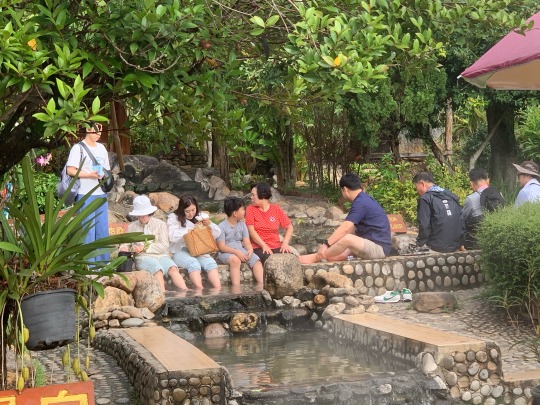
I decided that I’d pass on that treat.
About two hours later, we reached Wat Rong Khun, also known as the White Temple. Now, I’d been really looking forward to this temple since yesterday, when we were walking down the steps from the mountain temple. I overheard one person tell another that he absolutely HAD to go to the White Temple because it was the single best temple anywhere, even more impressive than the mountain temple.

Well, everyone has their own taste, I suppose, but the White Temple just wasn’t my cup of tea. Nor was it what I thought it would be. First, despite incorporating the ruins of an ancient temple, the buildings I saw were no earlier than the twenty-first century. Seriously. They’re the work of an artist by the name of Chalermchai Kositpipat who comes across as having the personality of Elon Musk and the taste of Donald Trump. Nothing that can be done to make the temple gaudy, tacky, and “over the top” has been overlooked.

That’s the second point about why I was disappointed. The outside of the temple is made of concrete painted with bright white paint and inlaid with bits of mirror to make it glitter like something Elvis Presley might have worn.
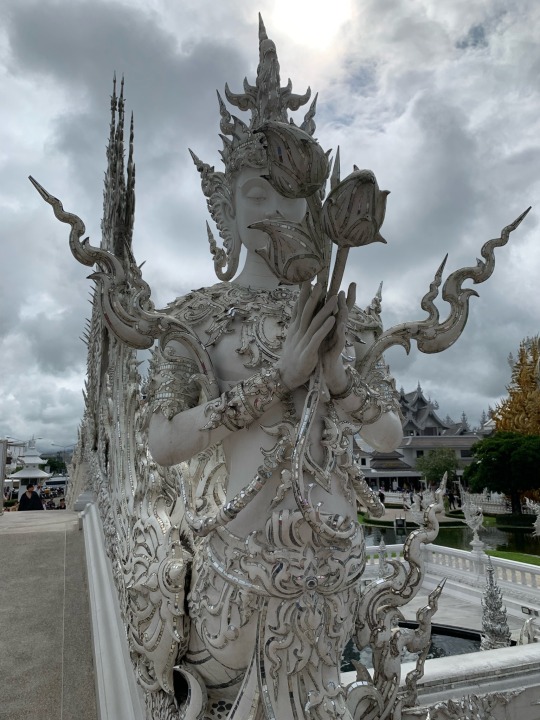
Third, the comparison to Elvis Presley is not an exaggeration. The symbolism at the temple is, at times, downright weird. In addition to traditional Hindu gods, the figures that are depicted in the main temple as saving mankind include Superman, Batman, Spider Man, and … um … Michael Jackson.
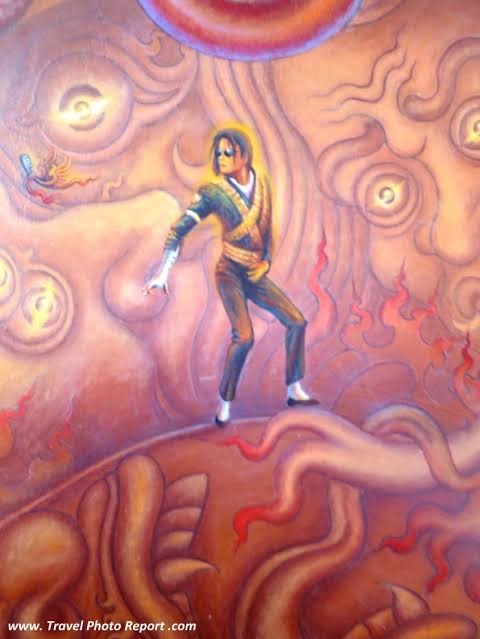
Note that the photo above had to be dowloaded off of the Internet. A sign said that we couldn't take photos inside this section of the temple, and as a rule-follower …
The decor of the White Temple was so over-the-top that I refrained from calling this place “Wat Disney" … aloud, at least, but I thought it often enough.
The temple complex is nominally Buddhist, but with strong Hindu influence. It’s supposed to be a microcosm of the universe. A moat surrounding the buildings represents the ocean. The lowest zone depicts people suffering in hell.

The main temple depicts the battle of good (Michael Jackson et al.) against evil (Osama bin Laden and other terrorists). The paradise section cannot be entered, and the nirvana section is not yet complete.

Almost as a relief afterward, we stopped at the Opium Museum, which traces the rise, development, and eventual eradication of the opium trade in the area. This was actually my favorite part of the day. On display is an assortment of “pillows” that opium users would recline on while smoking the drug,
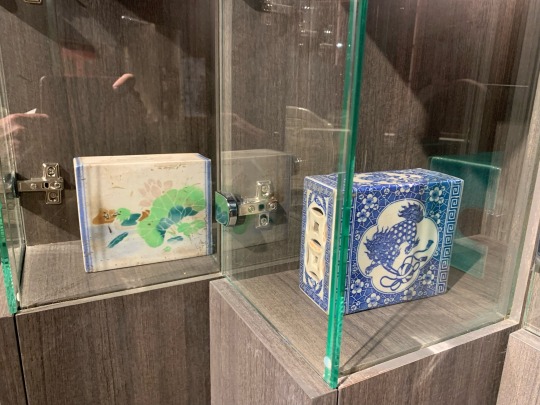
and a large array of opium pipes.

2 notes
·
View notes
Text

I suspect people miss my header image and assume its a Greek temple. If you look at the pillars for a second though, you'll see that it's very modern looking, even surreal. It is, in fact, a Serbian monument called "The Mausoleum of Struggle and Victory" from the socialist era. The aesthetic combines Modernism and Neo-Classicism. The photo itself is by Yang Xiao, as part of a series combining artificial lights with decaying socialist-era monuments at night, called "Eternal Monuments in the Dark."
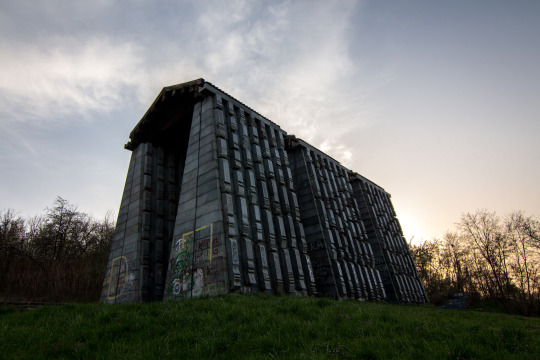
By framing socialist bloc architecture as classical ruins, and placing the democratic revolutions of Greece along side modern socialist revolutions, I'm making a point about historical narratives and associations. Ancient Mediterraneans didn't associate themselves with Northern Europeans, and to this day people are shocked by how "Eastern" Greek culture is. In many ways Islamic culture is more Roman than Western Culture. The Fascist fantasy of the past is just that: a fantasy. A tool they use for their political goals. They homogenize the diversity of Rome, they whitewash Greek statues, and they impose modern Classical music on cultures that wouldn't recognize it.
youtube
Liberals talk about how Ancient Greece is the foundation of Western Civilization™️, but they have no greater claim to it than Muslims or Buddhists. (The Greeks got around.) There is nothing in bourgeois political forms that's reminiscent of Athens, except perhaps for their hypocrisy towards their slaves. Many of the things the peasants and proletarians of Greece and Rome fought for were actively despised by Hamilton, Jefferson, and that whole lot of grifters. They hated universal male suffrage, they hated mass assemblies, they hated ballot measures, they hated rotation and sortition, and they hated land reform and debt abolition. They didn't love "the ancients," they loved their aristocrats.

Socialists have long loved the defeated reformers and revolutionaries of the ancient past. The first modern communist called himself "Gracchus Babeuf." What I'm doing isn't special. The point is to take the things the bourgeois order claims it's built on, and show how fake it all is.
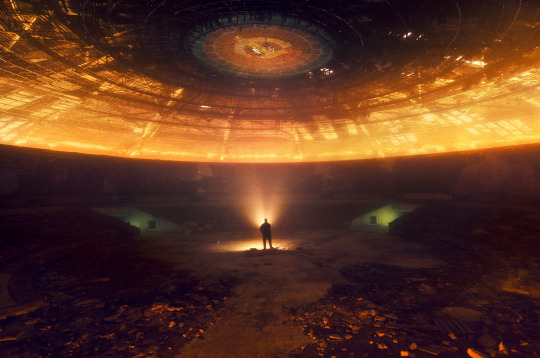
One day, the role the Classical Mediterranean plays in the modern superstructure will be replaced by the Socialist Bloc: a defeated experiment whose ruins global Communism will rest on. Their monuments, now covered in graffiti, will one day be visited by tourists the way the Parthenon is, to marvel at their glorious ambitions.
#socialism#communism#Marxism#history#Ancient Greece#Ancient Rome#architecture#historiography#Youtube#Soviet Union#Serbia
6 notes
·
View notes